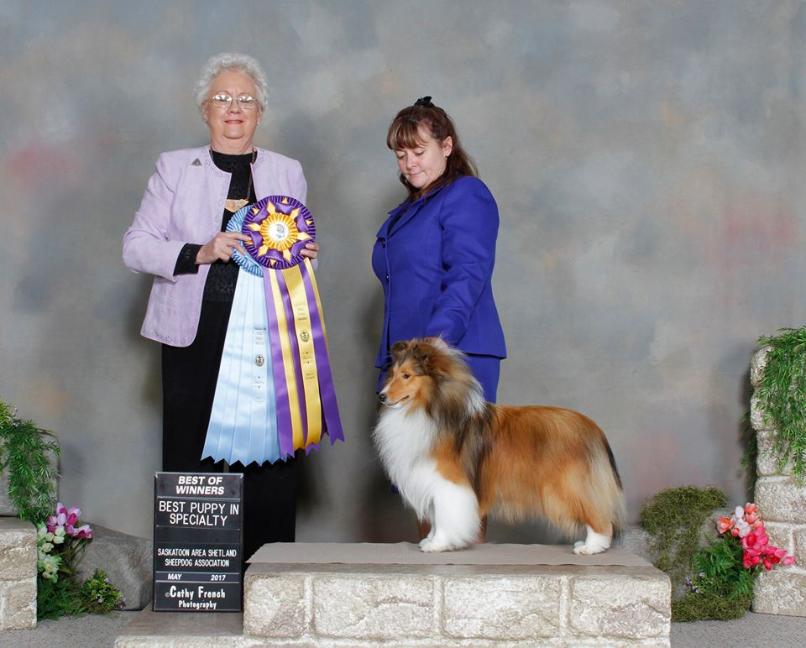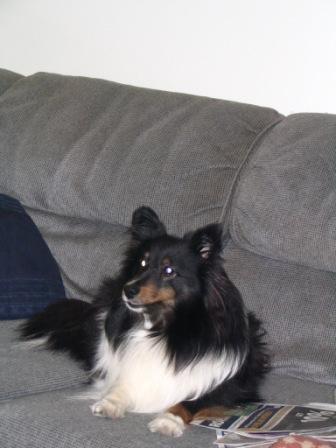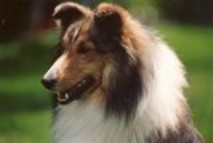Summer 2017 - Carley in front, dark sable is Goldenhilite's Rihanna (ptd) and Carley's son Weeskelf Dash To Fame aka RIO.
BPISS CH. WEESKELF LAUREATE DREAM ON - MAY 2017 - Carly's son. Ty has now sired a litter in which 3 of his 4 pups are now Champions!!!

ORIGIN ?
The Shetland Sheepdog is probably descended from Scottish Rough Collies brought to the Scottish ?island of Shetland and crossed with the Icelandic Yakkin, a small island dog (now no longer recognized) brought over in the boats of fishermen. By 1700, the breed was completely developed. For centuries these miniature dogs were used to herd and guard the sheep flocks of the Shetlands, those rugged islands off the Scottish coast where many of the animals are rather small in stature. Refinement of the breed took place mainly in the twentieth century after the export of Shelties to mainland Scotland and beyond. These small shepherds were very gentle when herding the miniature stock. One of the top obedience competition breeds, the Sheltie is an extremely smart and a willing worker. The Shetland Sheepdog was first recognized in England in 1909, and first registered in the United Stated in 1911. Because of his kindly disposition, the Sheltie has become one of todays most popular companion dogs. Some of the Shelties talents include: tracking, herding, watch dogging, guarding, agility, competitive obedience, and performing tricks.
AM CAN CH. Goldenhylite's Spice Girl - Rihanna's daughter Bred by Weeskelf & Golden Hylite

Grooming Your Dog
The Shetland Sheepdog has a soft, smooth double coat of medium length. Daily brushing is needed to keep mats from forming. The coat is easier to care for than you might expect, but regular brushing is important. Mist the coat lightly with water before you begin to tease out the mats before they get bad, but use the comb sparingly. This breed is a seasonally heavy shedder. The dense undercoat is shed twice a year: in the spring and fall. The coat readily sheds dirt and mud and Shelties are quite fastidious about their cleanliness. Bathe or dry shampoo only when absolutely necessary.
DESCRIPTION
The Shetland Sheepdog is a strong, nimble, lightly built, beautiful dog, with a long, wedge-shaped head. Its coat is rough with a soft undercoat. Some say they are almost a perfect miniature copy in of the long-haired collie. The top plane of the muzzle should be parallel to that of the skull. The glorious long double coat sports a lion-like mane and frill around the neck, and comes in blue merle, sable and black with various amounts of white and/or tan. The outer coat is lined with a dense, woolly undercoat. The legs and long tail are feathered, and the hair on the face and feet is smooth. The tail should reach to the hock. The almond-shaped eyes are generally dark, except in blue merle dogs where they may be blue or merle color. The dog should have a watchful, gentle, questioning and intelligent expression. The nose should be black. The teeth should meet in a scissors bite. The ears are small, flexible and expressive, with dropping tips. The Sheltie is an agile, swift dog and a good jumper. Dogs should appear masculine and bitches, feminine.
 GRACIE
GRACIE
TEMPERAMENT
The Shetland Sheepdog is an outstanding companion dog with a delightful temperament. Gentle, sensitive, loyal and dainty. Very lively, intelligent and trainable. The Shetland Sheepdog is one to the smartest breeds, very willing to please and obey. These dogs are so smart that many fanciers consider them to have almost human intelligence. Loving, loyal and affectionate with its family, but suspicious with strangers, especially with children, but they will put up with a lot from children in the family. The Sheltie is known to not allow themselves to be touched by strangers and will display noisy persistent barking. It is a good guard and watchdog. Socialize extensively as a puppy. This breed needs people and must be raised in a home where he can have a lot of companionship. They like to be kept busy. The Sheltie is above all an intelligent herder, capable both of commanding large cattle and holding small sheep in check. The herding instinct is still very strong in many of them. They love to chase things. Unfortunately - and often disastrously - they love to chase cars. A Sheltie should not be allowed to run free near a road as it may decide to chase a car or something else it sees across the road, running a high risk of getting hit by a car. Because of its beauty and kindness, the Sheltie has become a popular companion dog. This breed may bark a lot - I feel that if you teach your sheltie to talk (bark) then you can teach them to shush (be quiet). Some say males make better and more affectionate pets. The Sheltie is a home body dog in that it is not prone to running off to explore on its own.
 WEESKELF COOL BLUE ICE
WEESKELF COOL BLUE ICE
HEALTH PROBLEMS
Like the Rough Collie, there is a tendency toward inherited malformation and disease of the eyes. Each individual puppy should have his eyes examined by a qualified veterinary ophthalmologist by the age of two. C.E.R.F. eye tests can be done yearly. Some lines may be prone to hypothyroidism. It can also be affected by displacement of the patella (kneecap), hip dysplasia and a decrease in teeth growth (not having the proper number of teeth) which is thought to be inherited. The Sheltie is a very popular breed, leading to the sale of many inferior animals. Buy only from a reputable breeder. Do not over-feed the Sheltie.
 CH WEESKELF PINNACLE XTRA SPECIAL - Bounty
CH WEESKELF PINNACLE XTRA SPECIAL - Bounty
LIVING CONDITIONS
The Sheltie will do okay in an apartment if sufficiently exercised. They are fairly active indoors and will do okay without a yard. They still like to run outside for exercise as well as playing, doing agility, or obedience work which they thrive in. This active, graceful dog needs lots of exercise, which include a daily walk or jog. They will also enjoy running free; but be sure the dog is in a safe area.
CAN CH WEESKELF AH NEESH KAH BRANDY